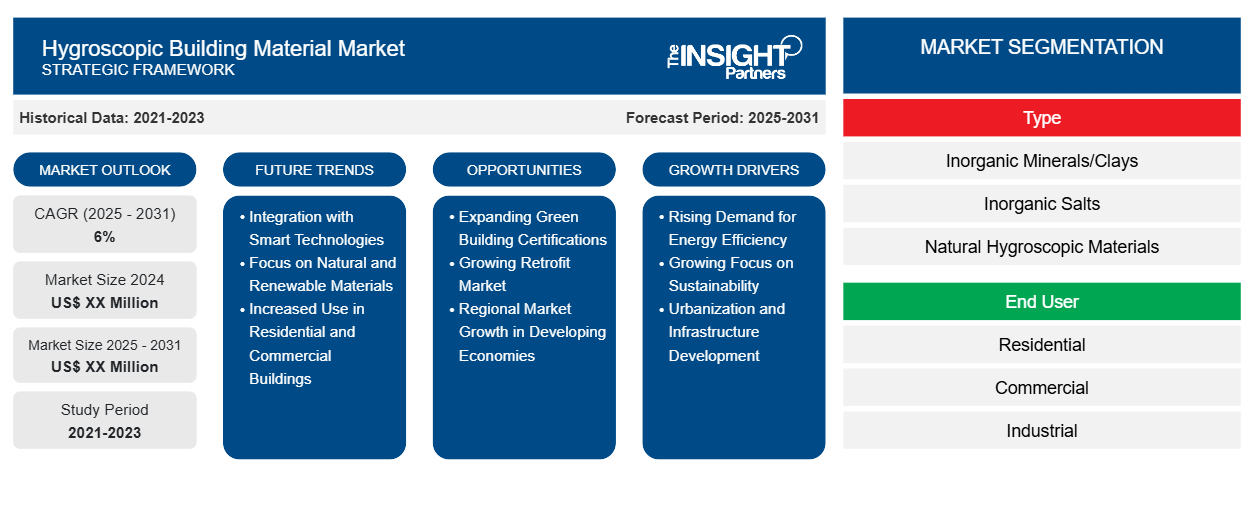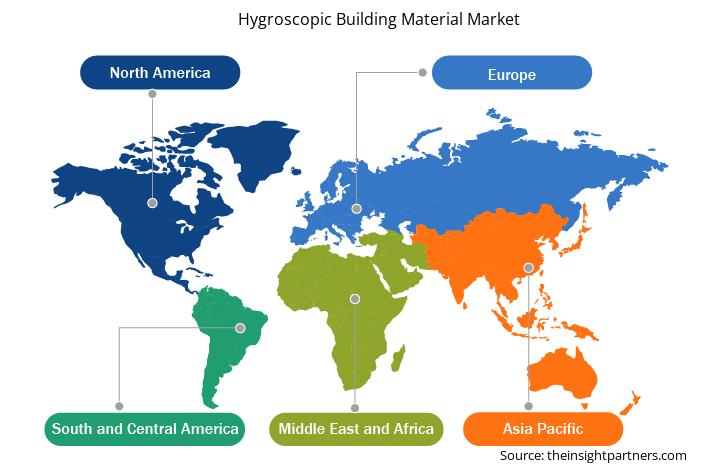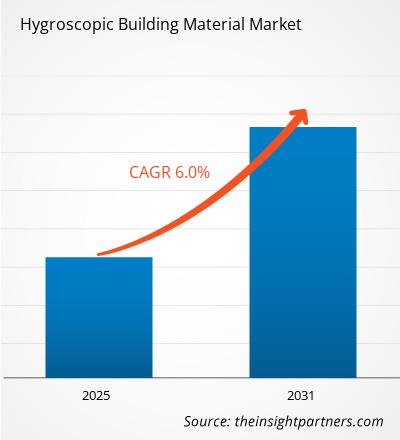The Hygroscopic Building Material Market is expected to register a CAGR of 6% from 2025 to 2031, with a market size expanding from US$ XX Million in 2024 to US$ XX Million by 2031.
The report is segmented by segmentation type (inorganic minerals/clays, inorganic salts, natural hygroscopic materials, molecular sieve, silica/silicon dioxide, others), end user (residential, commercial, industrial). The report further presents analysis based on application (building material, structural application). Global analysis is further broken-down at regional level and major countries. In terms of geography, the market is divided into North America, Europe, Asia Pacific, Middle East and Africa, and South and Central America). The report offers the Value in USD for the above analysis and segments.
Purpose of the Report
The report Hygroscopic Building Material Market by The Insight Partners aims to describe the present landscape and future growth, top driving factors, challenges, and opportunities. This will provide insights to various business stakeholders, such as:
- Technology Providers/Manufacturers: To understand the evolving market dynamics and know the potential growth opportunities, enabling them to make informed strategic decisions.
- Investors: To conduct a comprehensive trend analysis regarding the market growth rate, market financial projections, and opportunities that exist across the value chain.
- Regulatory bodies: To regulate policies and police activities in the market with the aim of minimizing abuse, preserving investor trust and confidence, and upholding the integrity and stability of the market.
Hygroscopic Building Material Market Segmentation
Type
- Inorganic Minerals/Clays
- Inorganic Salts
- Natural Hygroscopic Materials
- Molecular Sieve
- Silica/Silicon Dioxide
End User
- Residential
- Commercial
- Industrial
Application
- Building Material
- Structural Application
Customize This Report To Suit Your Requirement
You will get customization on any report - free of charge - including parts of this report, or country-level analysis, Excel Data pack, as well as avail great offers and discounts for start-ups & universities
Hygroscopic Building Material Market: Strategic Insights

- Get Top Key Market Trends of this report.This FREE sample will include data analysis, ranging from market trends to estimates and forecasts.
Hygroscopic Building Material Market Growth Drivers
- Rising Demand for Energy Efficiency: Hygroscopic building materials improve indoor air quality by regulating humidity levels, leading to better energy efficiency. As consumers and industries prioritize energy-efficient buildings, these materials are gaining traction. They reduce the need for excessive heating or cooling, promoting sustainable construction practices.
- Growing Focus on Sustainability: The increasing shift toward sustainable construction materials drives the demand for hygroscopic building materials. Their ability to absorb moisture naturally enhances building longevity and reduces maintenance costs. Environmental benefits, such as reducing the carbon footprint of buildings, make these materials an attractive choice in eco-friendly construction.
- Urbanization and Infrastructure Development: With rapid urbanization, there is a rising need for improved building performance. Hygroscopic materials, which regulate indoor humidity, contribute to healthier indoor environments in urban settings, where air quality can be compromised. Their adoption in large-scale infrastructure projects boosts demand in the market, fostering growth.
Hygroscopic Building Material Market Future Trends
- Integration with Smart Technologies: Hygroscopic building materials are increasingly being integrated with smart technologies to optimize indoor climate control. Sensors and automated systems that adjust humidity levels in real time enhance the effectiveness of these materials, leading to more energy-efficient and comfortable living spaces in modern smart homes and buildings.
- Focus on Natural and Renewable Materials: There is a growing trend toward using natural and renewable hygroscopic materials, such as wood, bamboo, and hemp. These materials not only regulate moisture but also contribute to a circular economy by being biodegradable, recyclable, and reducing the environmental impact of construction projects.
- Increased Use in Residential and Commercial Buildings: The demand for hygroscopic materials is expanding beyond commercial applications to residential buildings. Homeowners are seeking materials that provide better moisture control, reducing issues like mold and mildew, while enhancing indoor air quality. This trend is fueling innovation in products for both new constructions and renovations.
Hygroscopic Building Material Market Opportunities
- Expanding Green Building Certifications: As demand for sustainable construction increases, hygroscopic building materials offer a valuable opportunity for earning green building certifications like LEED or BREEAM. These materials contribute to environmental goals by improving energy efficiency, indoor air quality, and reducing carbon footprints, appealing to eco-conscious developers and consumers.
- Growing Retrofit Market: There is a significant opportunity in retrofitting existing buildings with hygroscopic materials to improve moisture management and energy efficiency. With an increasing focus on upgrading older buildings to meet modern sustainability standards, these materials provide a cost-effective solution to enhance the performance of existing structures.
- Regional Market Growth in Developing Economies: As urbanization accelerates in developing countries, the demand for affordable, sustainable building materials is rising. Hygroscopic materials present an opportunity to improve indoor climate and energy efficiency in these regions, offering a competitive edge in markets where energy efficiency and air quality are becoming top priorities.
Hygroscopic Building Material Market Regional Insights
The regional trends and factors influencing the Hygroscopic Building Material Market throughout the forecast period have been thoroughly explained by the analysts at Insight Partners. This section also discusses Hygroscopic Building Material Market segments and geography across North America, Europe, Asia Pacific, Middle East and Africa, and South and Central America.

- Get the Regional Specific Data for Hygroscopic Building Material Market
Hygroscopic Building Material Market Report Scope
| Report Attribute | Details |
|---|---|
| Market size in 2024 | US$ XX Million |
| Market Size by 2031 | US$ XX Million |
| Global CAGR (2025 - 2031) | 6% |
| Historical Data | 2021-2023 |
| Forecast period | 2025-2031 |
| Segments Covered |
By Type
|
| Regions and Countries Covered | North America
|
| Market leaders and key company profiles |
Hygroscopic Building Material Market Players Density: Understanding Its Impact on Business Dynamics
The Hygroscopic Building Material Market market is growing rapidly, driven by increasing end-user demand due to factors such as evolving consumer preferences, technological advancements, and greater awareness of the product's benefits. As demand rises, businesses are expanding their offerings, innovating to meet consumer needs, and capitalizing on emerging trends, which further fuels market growth.
Market players density refers to the distribution of firms or companies operating within a particular market or industry. It indicates how many competitors (market players) are present in a given market space relative to its size or total market value.
Major Companies operating in the Hygroscopic Building Material Market are:
- Porocel Corporation
- W.R. Grace
- Clariant
- BASF SE
- Arkema SA
- Honeywell International
Disclaimer: The companies listed above are not ranked in any particular order.

- Get the Hygroscopic Building Material Market top key players overview
Key Selling Points
- Comprehensive Coverage: The report comprehensively covers the analysis of products, services, types, and end users of the Hygroscopic Building Material Market, providing a holistic landscape.
- Expert Analysis: The report is compiled based on the in-depth understanding of industry experts and analysts.
- Up-to-date Information: The report assures business relevance due to its coverage of recent information and data trends.
- Customization Options: This report can be customized to cater to specific client requirements and suit the business strategies aptly.
The research report on the Hygroscopic Building Material Market can, therefore, help spearhead the trail of decoding and understanding the industry scenario and growth prospects. Although there can be a few valid concerns, the overall benefits of this report tend to outweigh the disadvantages.
- Historical Analysis (2 Years), Base Year, Forecast (7 Years) with CAGR
- PEST and SWOT Analysis
- Market Size Value / Volume - Global, Regional, Country
- Industry and Competitive Landscape
- Excel Dataset



Report Coverage
Revenue forecast, Company Analysis, Industry landscape, Growth factors, and Trends

Segment Covered
This text is related
to segments covered.

Regional Scope
North America, Europe, Asia Pacific, Middle East & Africa, South & Central America

Country Scope
This text is related
to country scope.
Frequently Asked Questions
The hygroscopic building material market is estimated to witness a CAGR of 6% from 2025 to 2031
The increasing shift toward sustainable construction materials drives the demand for hygroscopic building materials bolstering the market growth.
Porocel Corporation, W.R. Grace, Clariant, BASF SE, Arkema SA, Honeywell International, Jalon Chemicals, Hengye Inc, Dessica Chemicals, Fuji Silysia Chemical Ltd. are the key players operating in the hygroscopic building material market.
On the basis of geography, the market is segmented into is classified into North America, Europe, Asia Pacific, Middle East and Africa, and South and Central America.
Based on geography, North America held the largest share of the hygroscopic building material market.
The report can be delivered in PDF/Word format, we can also share excel data sheet based on request.
Trends and growth analysis reports related to Chemicals and Materials : READ MORE..
- Porocel Corporation
- W.R. Grace
- Clariant
- BASF SE
- Arkema SA
- Honeywell International
- Jalon Chemicals
- Hengye Inc
- Dessica Chemicals
- Fuji Silysia Chemical Ltd.

 Get Free Sample For
Get Free Sample For